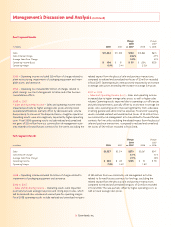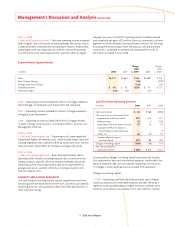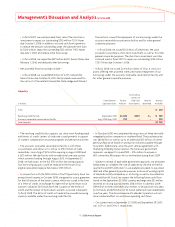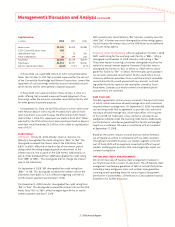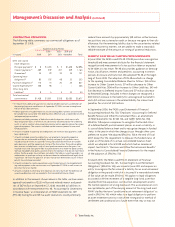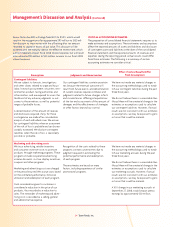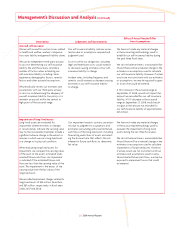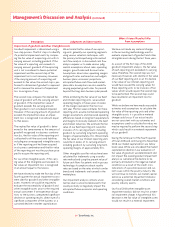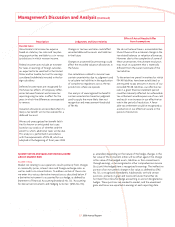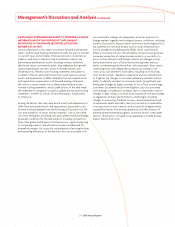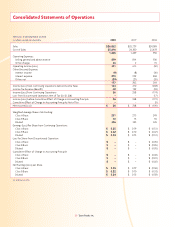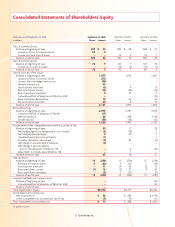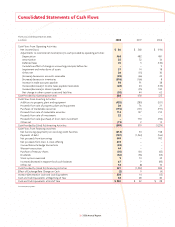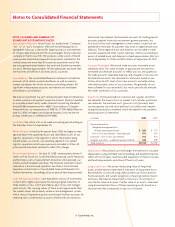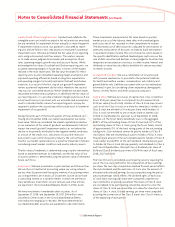Tyson Foods 2008 Annual Report Download - page 28
Download and view the complete annual report
Please find page 28 of the 2008 Tyson Foods annual report below. You can navigate through the pages in the report by either clicking on the pages listed below, or by using the keyword search tool below to find specific information within the annual report.
26 Tyson Foods, Inc.
Management’s Discussion and Analysis (continued)
Description Judgments and Uncertainties
Effect if Actual Results Differ
from Assumptions
Goodwill impairment is determined using a
two-step process. The fi rst step is to identify
if a potential impairment exists by compar-
ing the fair value of a reporting unit with its
carrying amount, including goodwill. If the
fair value of a reporting unit exceeds its
carrying amount, goodwill of the reporting
unit is not considered to have a potential
impairment and the second step of the
impairment test is not necessary. However,
if the carrying amount of a reporting unit
exceeds its fair value, the second step is per-
formed to determine if goodwill is impaired
and to measure the amount of impairment
loss to recognize, if any.
The second step compares the implied fair
value of goodwill with the carrying amount
of goodwill. If the implied fair value of
goodwill exceeds the carrying amount,
then goodwill is not considered impaired.
However, if the carrying amount of goodwill
exceeds the implied fair value, an impair-
ment loss is recognized in an amount equal
to that excess.
The implied fair value of goodwill is deter-
mined in the same manner as the amount of
goodwill recognized in a business combina-
tion (i.e., the fair value of the reporting unit
is allocated to all the assets and liabilities,
including any unrecognized intangible assets,
as if the reporting unit had been acquired
in a business combination and the fair value
of the reporting unit was the purchase price
paid to acquire the reporting unit).
For our other intangible assets, if the carry-
ing value of the intangible asset exceeds its
fair value, an impairment loss is recognized
in an amount equal to that excess.
We have elected to make the fi rst day of the
fourth quarter the annual impairment assess-
ment date for goodwill and other intangible
assets. However, we could be required to
evaluate the recoverability of goodwill and
other intangible assets prior to the required
annual assessment if we experience disrup-
tions to the business, unexpected signifi cant
declines in operating results, divestiture of a
signifi cant component of the business or a
sustained decline in market capitalization.
We estimate the fair value of our report-
ing units, generally our operating segments,
using various valuation techniques, with
the primary technique being a discounted
cash fl ow analysis. A discounted cash fl ow
analysis requires us to make various judg-
mental assumptions about sales, operating
margins, growth rates and discount rates.
Assumptions about sales, operating margins
and growth rates are based on our budgets,
business plans, economic projections,
anticipated future cash fl ows and market-
place data. Assumptions are also made for
varying perpetual growth rates for periods
beyond the long-term business plan period.
While estimating the fair value of our Beef
and Chicken reporting units, we assumed
operating margins in future years in excess
of the margins realized in the most cur-
rent year. The fair value estimates for these
reporting units assume normalized operating
margin assumptions and improved operating
effi ciencies based on long-term expectations
and margins historically realized in the beef
and chicken industries. We estimate the fair
value of our Beef reporting unit would be
in excess of its carrying amount, including
goodwill, by sustaining long-term operating
margins of approximately 2.3%. We estimate
the fair value of our Chicken reporting units
would be in excess of its carrying amount,
including goodwill, by sustaining long-term
operating margins of approximately 5.1%.
Other intangible asset fair values have been
calculated for trademarks using a royalty
rate method and using the present value of
future cash fl ows for patents and in-process
technology. Assumptions about royalty
rates are based on the rates at which similar
brands and trademarks are licensed in the
marketplace.
Our impairment analysis contains uncer-
tainties due to uncontrollable events that
could positively or negatively impact the
anticipated future economic and operating
conditions.
We have not made any material changes
in the accounting methodology used to
evaluate impairment of goodwill and other
intangible assets during the last three years.
As a result of the fi rst step of the 2008
goodwill impairment analysis, the fair value
of each reporting unit exceeded its carrying
value. Therefore, the second step was not
necessary. However, a 6% decline in fair value
of our Beef reporting unit or an 11% decline
in fair value of our Chicken reporting unit
would have caused the carrying values for
these reporting units to be in excess of fair
values which would require the second step
to be performed. The second step could
have resulted in an impairment loss for
goodwill.
While we believe we have made reasonable
estimates and assumptions to calculate the
fair value of the reporting units and other
intangible assets, it is possible a material
change could occur. If our actual results
are not consistent with our estimates and
assumptions used to calculate fair value, we
may be required to perform the second step
which could result in a material impairment
of our goodwill.
During the latter part of the fourth quarter
of fi scal 2008 and continuing into November
2008, our market capitalization was below
book value. While we considered the market
capitalization decline in our evaluation of
fair value of goodwill, we determined it did
not impact the overall goodwill impairment
analysis as we believe the decline to be
primarily attributed to the negative market
conditions as a result of the credit crisis,
indications of a possible recession and cur-
rent issues within the poultry industry. We
will continue to monitor our market capital-
ization as a potential impairment indicator
considering overall market conditions and
poultry industry events.
Our fi scal 2008 other intangible asset
impairment analysis did not result in a mate-
rial impairment charge. A hypothetical 10%
decrease in the fair value of intangible assets
would not result in a material impairment.
Impairment of goodwill and other intangible assets


